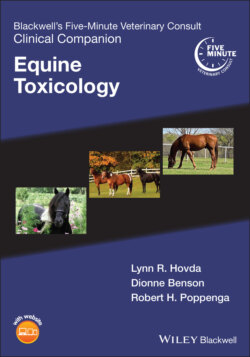Читать книгу Blackwell's Five-Minute Veterinary Consult Clinical Companion - Группа авторов - Страница 27
Common Terms and Definitions
ОглавлениеDetection limits. The lowest level at which a test can reliably detect the analyte. The more sensitive the test, the lower the detection limit. For drug concentrations, general units range from picograms per milliliter (pg/mL; most sensitive) to micrograms per milliliter (μg/mL; least sensitive).
Drug. A substance that has a physiological effect when introduced into the organism.
ELISA (enzyme linked immunosorbent assay). The assay uses an enzyme linked to either antibody or antigen. When the analyte is present, the coupled enzyme reacts with a substrate, causing a color change.
FID (flame ionization detector). Can be coupled to gas chromatographs for separation of analytes. Toxicology applications include ethanol testing.
Forensic testing. Test results may be used in a legal setting and any sample collected for this purpose will require special handling to document the chain of custody of the sample. Data to support a test result must be scientifically and legally defensible.
GC (gas chromatography). A separation technique that can separate components of a mixture for detection and/or quantification. The sample must be able to be volatilized and is generally restricted to lower‐molecular‐weight compounds (less than 500–600 amu).
ECD (electron capture detector). Used to detect halogenated compounds, i.e., compounds containing bromine, chlorine, fluorine, or iodine. Can be coupled to gas chromatographs for separation of analytes. Toxicology applications include pesticide analysis in body fluids.
GC‐MS (gas chromatography–mass spectrometry). A technique used for the separation, detection, and confirmation of volatile, non‐polar, and lower‐molecular‐weight (< 500–600 amu) compounds within a test sample. It is generally not suitable for analysis of larger molecules, such as peptides, proteins, or metals. It is considered a “gold standard” test for positive identification when the right parameters are used. Crucial parameters for successful performance include the ability of the target molecule to be volatilized, choosing the correct extraction, temperature range for separation, column chemistry, carrier gas, and ionization mode. If the identity of the target molecule is not known, the test can yield a false negative. Toxicology applications are numerous in the field of small molecule drug analysis.
HS (headspace). Involves sampling of volatile analytes from a sample. Toxicology analytes include alcohols (ethanol, methanol, isopropanol, etc.) and carbon dioxide/carbon monoxide. Headspace sampling can be coupled to gas chromatography for separation of analytes and FID or MS detection techniques. An example is HS‐GC‐MS.
HPLC (high performance liquid chromatography). A technique that can separate components of a mixture for detection and/or quantification. Unlike gas chromatography, the sample is in a liquid state and can also test larger‐molecular‐weight compounds such as peptides and proteins under the correct conditions. Another significant advantage over gas chromatography is that the technique is much faster and offers the user more flexibility with separation of analytes.
IA (immunoassay). Any test using an antigen–antibody interaction. Examples include radioimmunoassay, enzyme immunoassay (EIA or ELISA), fluorescence immunoassay (FIA), or chemiluminescence immunoassays (CLIA). Immunoassays can be fast and economical, if targeting a specific compound, and offer varying degrees of sensitivity. However, immunoassays can also lack specificity and are not available for every type of drug/toxin/toxicant. Quantitation can be unreliable due to cross‐reactivity with structurally similar compounds. The test cannot be used for legally defensible test results.
ICP‐MS (inductively coupled plasma‐mass spectrometry). Uses a plasma state to ionize samples and is used mainly for the detection of elements. It has wide application in the fields of inorganic trace analysis and food testing. Nearly every element in the periodic table can be analyzed by ICP‐MS. Toxicology applications include the analysis of metals in body fluids, such as cobalt, arsenic, nickel, etc.
LC‐MS (liquid chromatography‐mass spectrometry). Like GC‐MS, except using a liquid sample state. It is also a gold standard for scientifically and legally defensible testing. It is generally faster than GC‐MS and provides more user flexibility to optimize separation, sensitivity, and specificity.
MS (mass spectrometry). After separation of components in a sample using gas or liquid chromatography, the individual compounds are introduced into the mass spectrometer, where molecules are ionized and fragmented. The fragmentation pattern of individual molecules is highly specific under standardized conditions. Each ion fragment can be measured by the instrument and the resulting mass spectrum can be compared with certified reference materials for identification.
RIA (radioimmunoassay). A type of immunoassay using radio‐labeled antigens or antibodies. If the target analyte is present, it will bind to the radio‐labeled component and the resulting radioactive complex can be very accurately measured. While a very sensitive technique, it has fallen out of favor due to exposure hazards and problems with disposal of used test materials.
Toxin. A toxin is an antigenic poison or venom produced by living cells. Nature provides it as either a weapon for predation or as a defense mechanism:If it bites you and you die, it is venomous. If you bite it and you die, it is poisonous.Examples: botulinum toxin (from Clostridium botulinum), muscarine (from mushrooms), tetrodotoxin (puffer fish).
Toxicant. A toxicant is any substance (natural or synthetic) capable of causing ill health.Examples: pesticides, benzene, cyanide.
UHPLC (ultra‐high‐performance liquid chromatography). As implied by the term “ultra”, UHPLC offers higher speed of analysis, and better sensitivity, reproducibility, and specificity over HPLC.
